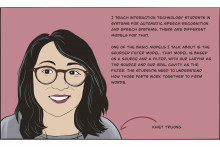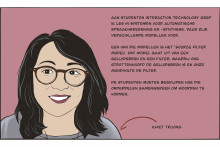What is ‘skin hunger’ and why do we have it?
Van Erp: ‘It is our inherited longing for human touch. We are social animals. Like for all mammals, bonding and the sense of community is built through physical contact. Our skin is not just a bag that keeps our organs together, it is a complex sensory organ. There are in fact two sensing mechanisms in our skin. One is functional, so that we are able to recognize objects through touch. But there is also a specialized sensory system to process social touch. It exists for social communication and it is even embedded in a different part of our brain. Skin hunger is therefore a truly physiological reaction. It is wired into our body.’
It is a physical reaction. How does it impact our wellbeing?
‘Besides the physical aspect, skin hunger also stems from psychological need. If you are not cared for and touched as a child, you will not grow up to be a healthy, socially well-functioning adult. This was observed for example on children from orphanages, who were neglected and didn’t have much physical interaction with their caregivers. The same happens for all other mammals if they are separated from their mother and social contacts: they suffer. The term ‘skin hunger’ actually originates from describing the need for physical interaction between a mother and a child.’
Does this mean that skin hunger is universal? Does everyone experience it?
‘There are of course individual differences, but it is universal across mankind. The need for touch, especially in early life, is crucial. It is of course not the same across cultures. Here in the Netherlands, we are actually quite touch deprived compared to other cultures where it’s more common to embrace each other and touch each other in public.’
However, even here, many people say they experience skin hunger. Also in relation to their colleagues.
‘I think this is partly caused by the fact that we unconsciously touch more than we think. In normal life, we shake hands or pat someone’s shoulder more than we realize. That is what people miss now. Moreover, touching someone means you are close by. It is not just a reaction of our bodies, but also our minds.’
Do you have any tips on how to cope with skin hunger?
‘Even touching your cat or another pet helps. The stroking movements have a calming effect. This is shown also in care homes, where elderly or disabled people use robotic pets. Even stroking a toy can have beneficial impact on our wellbeing. Just remember when you were a child. If you were scared, you’d probably clutch your teddy bear for comfort.’
As you mentioned, we know that a lack of social touch in childhood leads to socially dysfunctional adults. What happens if you have insufficient physical contact as an adult?
‘We actually don’t know yet. This hasn’t been researched, but this question has become relevant now. So far research has focused on infants and children and on positive effects of touch. However, we already know that touch really impacts your physiological processes – a touch of a loved one can slow your heartrate in a stressful situation, for instance. But touch also impacts your social behavior. There is something we call ‘Midas touch’, it’s a phenomenon showing that if a stranger touches you on your arm, you are more likely to comply with their requests. If a waiter in a restaurant briefly touches you, you are more likely to give them a higher tip.’
Is there anything we can do to prevent skin hunger?
‘At the University of Twente, we are exploring technology that would add social touch to communication over distance. Although ‘touching’ each other isn’t necessary in many conversations, such as professional meetings, it could be truly beneficial in contact with close friends or family. Imagine how much it would mean to you if you were in a hospital, not allowed any physical contact with anyone, and your family could at least hold your hand – through technology. Touch is very important for us, more than we think. Even a simple handshake tells you a lot about your social partner.’
What type of ‘social touch’ technology is available at the moment?
‘There is very little available on the market. Most is based on mechanical stimulation, such as feeling pressure or vibrations. Developing haptic technology is very difficult. The progress is slow, but I believe the Covid-19 pandemic could boost this research because we now see how important it is. Either way, it is very difficult to mimic real social touch. When we touch, we feel the softness of the skin, the warmth of the body, the slight pressure… can we replicate the same experience using a metal device, for example? We don’t know. But I strongly believe there are many ways we can and should improve communication over distance. Although we can see and hear each other, we are still far far away from mimicking a meeting in real life. Even with all the technology available now, I don’t feel really socially connected to the people I see on my screen.’
jan van erp
Jan van Erp is Professor of Tangible User Interaction at the Human Media Interaction group and has appointment as principal scientist with The Netherlands Organization for Applied Scientific Research TNO. His field of expertise is using discriminative touch in haptic and tactile displays and social touch in mediated communication and interaction with virtual agents and robots.








